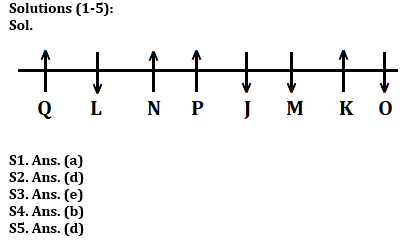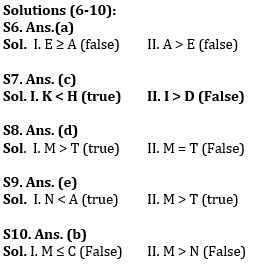Directions (1-5): Study the information carefully and answer the questions given below.
Eight persons J, K, L, M, N, O, P and Q are sitting in a row some of them face towards north and some face towards south but not necessary in the same order. Not more than two consecutive persons face same direction.
N sits second to the right of J. Q sits second to the left of N. Two persons sit between Q and P. More than three persons sit between L and O. The persons sit at extreme ends face opposite direction to each other. M sits second to the right of P. N is not immediate neighbor of M who sits third from one of the extreme ends of row. O is not immediate neighbor of N and M. O face south direction. J sits immediate right of M. L face opposite direction to Q.
Q1. Who among the following person sits second to right of O?
(a) M
(b) P
(c) J
(d) K
(e) None of these
Q2. How many persons sit between N and K?
(a) One
(b) Two
(c) Four
(d) Three
(e) None of these
Q3. Who among the following person is immediate neighbor of P and M?
(a) L
(b) O
(c) K
(d) Q
(e) None of these
Q4. How many persons sit to the right of M?
(a) One
(b) More than Four
(c) Three
(d) Four
(e) None
Q5. Four of the following five are alike in certain way based on a group, find the one who does not belong to that group?
(a) Q
(b) N
(c) K
(d) J
(e) P
Directions (6-10): In these questions, a relationship between different elements is shown in the statements. The statements are followed by two conclusions. Give answer
Q6. Statement: A < B; G < D > E; G < F > B
Conclusion: I. E ≥ A
II. A > E
(a) If either conclusion I or II is true
(b) If only conclusion I is true
(c) If neither conclusion I nor II is true
(d) If only conclusion II is true
(e) If both conclusions I and II are true
Q7. Statement: D > K ≥ J; D ≤ S = H; I > K
Conclusion: I. K < H
II. I > D
(a) If both conclusion I and II are true
(b) If neither conclusion I nor II is true
(c) If only conclusion I is true
(d) If either conclusion I or II is true
(e) If only conclusion II is true
Q8. Statement: K < L < M ≥ S; K ≥ O > T
Conclusion: I. M > T
II. M = T
(a) If only conclusion II is true
(b) If either conclusion I or II is true
(c) If neither conclusion I nor II is true
(d) If only conclusion I is true
(e) If both conclusions I and II are true
Q9. Statement: Q > T > N; A > S > Q; A < M
Conclusion: I. N < A
II. M > T
(a) If only conclusion II is true
(b) If only conclusion I is true
(c) If neither conclusion I nor II is true
(d) If either conclusion I or II is true
(e) If both conclusions I and II are true
Q10. Statement: D > B ≤ C; F < M ≤ D; C = N
Conclusion: I. M ≤ C
II. M > N
(a) If only conclusion II is true
(b) If either conclusion I or II is true
(c) If neither conclusion I nor II is true
(d) If only conclusion I is true
(e) If both conclusions I and II are true
Solutions







 GA Capsule for SBI Clerk Mains 2025, Dow...
GA Capsule for SBI Clerk Mains 2025, Dow...
 The Hindu Review October 2022: Download ...
The Hindu Review October 2022: Download ...
 Without These Documents, Your Bank Exam ...
Without These Documents, Your Bank Exam ...





